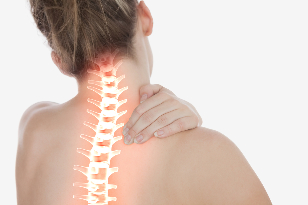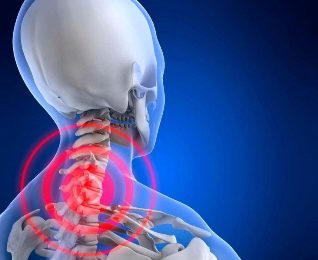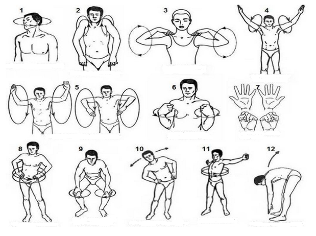Rarely that is not confronted with manifestations of this widespread of the disease: according to statistics, about 60% of the population in the developed countries, to varying degrees, suffer from the manifestations of degenerative disease of the disc. The main reasons for the importance and – sedentary work and the lack of movement, of the modern man.

Osteochondrosis of the cervical spine (Osteohondroz) is degenerate-dystrophic lesions of the intervertebral discs, the following which are damaged, the discs, the vertebrae and the joints of the cervical spine, observed a decrease in height of intervertebral discs. As the disease progresses, if it is not treated, and can cause headaches, disturbances of the blood circulation and even hernia. Like osteoporosis, the disease occurs due to the violation of mineral metabolism, a result of which the bones and joints economic less stable.
Osteochondrosis can lead to instability of the cervical spine (the symptoms and treatment are similar to with chondrosis, but have a number of characteristics), which is often accompanied by a displacement of the vertebrae. In turn, it accelerates the development of degenerative disease of the disk, destroying vertebral division.
Osteochondrosis of the cervical spine: symptoms
In the early stages of the disease almost does not manifest itself by painful symptoms: you may feel an unpleasant sensation in the neck after physical exertion or prolonged sitting in a posture, after the strong movement or tilt of the head.
The main symptoms of headache, dizziness and impaired coordination, slight crackling at the movement of the head, general weakness; rarely observed weakness of arm, numbness of the tongue and speech disorders, breathing problems, vision, hearing, increased sweating, abnormally high blood pressure. The main areas of the neck, the neck, collar area. In most cases, simultaneously, we only observe some of these signs of the disease.
In general, the symptoms of degenerative disc disease is not obvious, they often mask the use of drugs for the pain. And this is one of its dangers: most of the symptoms are possible in other diseases, making difficult the diagnosis of cervical osteoarthritis.
Dizziness in osteochondrosis cervical
Such a state is not always clearly the osteochondrosis of the cervical spine.
The dizziness may be the result of:
- inflammation in the middle or inner ear;
- spasms of the blood vessels of the brain;
- interruption in the transmission of nerve impulses;
- problems with the vestibular system;
- diseases of the cardio-vascular system.
No clear criteria for vertigo low back pain. However, there is a system and non-systemic vertigo, they have explicit differences.
It is recommended to know the differences of system and non-system as you install the dizzy, you will help to determine the causes of the unusual state:
- the system vertigo is a sensation of circular motion of surrounding objects, or of the body, which is a consequence of disrupting the functioning of the vestibular apparatus, analyzers and the receptors in the joints, muscles and the epidermis (the low back pain of various etiologies);
- non-system vertigo is a feeling of weakness, feeling light-headed, uncertain of the state in the vertical position. If no system of dizziness, the sensation of machine rotation is absent, and it is a major difference compared to the signs.
A person receiving, the dizziness of one of these types must be viewed with a physician experienced in the first place, a neurologist, or (in the case of suspicion on disease of the ear and the nasopharynx), nose and throat specialist.
The excuse of the emergency of the hospital, is not related to osteochondrosis of the cervical spine, is to identify the patient (with the exception of vertigo) features such as:
- the paralysis of the muscles of the face and numbness of the part of the shoulder girdle;
- headaches, on a background of deterioration of health;
- disorders of coordination of movements;
- the loss or disappearance of the consciousness.
Headache when the low back pain cervical
This is one of the most common non-specific signs of many diseases of man. Headaches are particularly common in the population. It is difficult to determine the cause of headaches, and, above all, linked to lesions of the spinal column. Found about 14 different causes of headache in man.
The most common causes of headaches when you fast make us of the pathology:
- spasms of the blood vessels of the brain;
- the entrapment of nerve roots are;
- reflex increase in intracranial pressure.
Headache when the low back pain cervical can recall the sensations when high blood pressure, angina, or a stroke. Especially among people middle-aged and older, generally, there is a risk of development of stroke or myocardial.
The sensation of the pain may be paroxysmal, constant, throbbing and dull.
In heart disease, the patients complain of an unpleasant sensation in the chest, accompanied by heart rhythm disorders. Determine the cause can only a qualified medical practitioner. In case of headache, in harmony with the nausea, dizziness, and retrosternal pain necessarily the fact of the ECG.
The pain osteochondrosis cervical
Is not always the pain is localized precisely in the region of the head and nape of the neck. Known cases of a different location of the pain.
Neck pain may radiate into the shoulder area and in different parts of the hand. A distinctive feature of these feelings is the suddenness of crises, after sleep, sudden movements, of man's subtle tension, for example, when laughing or sneezing. The pain associated with osteochondrosis, if the process has not taken a chronic nature, usually subsides after a short period of time and is married with a cracking in the cervical vertebrae.
Without the consent of the investigation should not remove the pain by using manual therapy (massage). In some cases, incapable of manipulation can exacerbate the condition, disrupt sexuality, and lead to a disability.
By the intensity of the pain can be moderate or strong. The length of time that short-and long-term.
It is noticed that the osteochondrosis cervical is most often associated with lesions of the sixth and seventh cervical vertebrae.
There are tests to determine the location of the household, the pain of the pulse. The defeat in the field of the sixth vertebra is complemented by pain in the thumb, and the defeat in the area of the seventh vertebra accompanied by painful sensations in the average finger.
The blood pressure during osteochondrosis cervical
The link of the cervical arthritis with a blood pressure irregular long established. The cervical vertebrae are important, the nerves and the blood vessels.
Characterized by jumps of pressure in the course of the day. High blood pressure for a long period of time is not characteristic of this disease. Reflex irritation of the nerve endings and in the short-term spasms of blood vessels causing jump daily of the dynamics of hypertension.
A distinctive feature of the increased pressure during osteochondrosis cervical is the combination of the following symptoms:
- headaches;
- pain in the limbs and the chest;
- the decrease of the sensitivity in the area of the zone;
- the occurrence of pressure variations after stress, muscle tension, and a long stay in an uncomfortable position and other similar situations.
A sudden change of HELL, and the rapid deterioration of the health are the basis for the emergency treatment of his coming.
The stage of development of degenerative disc disease
In the development of cervical osteoarthritis has decided to allocate 4 stages. But it is quite classical in the division, as most of the symptoms of the disease may occur in other pathologies.
The first phase (pre-clinical)
In the initial phase of mild symptoms and is often due to stress or other diseases. One feels an unpleasant stiffness in the neck, pain during sudden movements or the slopes. At this stage, it is possible to get rid of the outbreak of the degenerative disc disease with the help of gymnastics, or simply to move, adjust the power supply.
The second step
The pain increases, economic standing, in bends or slopes already strong. Appear severe headache, the patient begins to tire quickly, is diffuse, regularly numb areas of the face.
The third step
The formation of a disk herniation often causes dizziness, weakness in the arms, aching in the back of the head and hands constantly feel in the shoulders.
The fourth stage
In the end, the intervertebral discs are destroyed, they are replaced by connective tissue. The nerves are to the zaselyalsya, which causes difficulties in the movement, the acute pain, strengthening of dizziness, appears tinnitus.
Causes and risk factors
Curiously, the possibility of the development of degenerative disc disease in humans is caused by one of its advantages evolutionary – standing posture: the vertebrae sit one on top of the other, and with age, the connective tissue degrades. As a result, in the elderly, it is almost inevitable. But there are a multitude of factors that favor a more early and intensive development of cervical osteoarthritis:
- In the first place – it is sedentary, and a sedentary lifestyle, often observed in modern life (office workers, drivers and other "sedentary" of the specialty, the television, long hours in front of a computer), lack of exercise
- Strained, abnormal postures in the work process: for example, the computer of the person is often leaning forward, taking the pose tense
- The opposite the reason is too high, unusual for this person to charge; but in a risk zone – the same formed by the athletes, for example, the weightlifters;
- The causes, violent natural posture of man: uncomfortable shoes, especially high heels, the failure of the posture during sleep, flat feet, rheumatism, scoliosis;
- The excess of weight, which is often caused by poor diet
- Stress frequent, high voltage and constant fatigue
- Local hypothermia
That dangerous osteochondrosis cervical
In the region of the neck, there are many vital vessels, the board of trustees of the arteries, the capillaries, so that any violation of it can have unpleasant consequences, including the deprivation of oxygen, hypertension, vascular dystonia.

Osteochondrosis cervical striking segments of the spinal column, control joints and the joints of the elbow, thyroid, hands and other organs. Low back pain, if it is not treated, the likelihood of pinching of the nerves are to, the compression of the vessels, which inevitably has repercussions on the work of other bodies.
How to treat osteochondrosis cervical
The real, stable success in the treatment of cervical osteoarthritis can be achieved if an integrated approach that includes medication, massage area, gym, medical and physiotherapy. In particular, the severe cases may require surgical intervention.
We recommend that you do not use self-medication, mostly due to the fact that the symptoms of the degenerative disease of the discs can be served with any other disease: some of what you have selected key medicines do not help in treatment, they may cause damage.
Withdrawal of acute pain
Osteochondrosis, particularly in the later stages, accompanied by intense pain, so that the first task of the doctor is to alleviate your suffering. He will prescribe painkillers, anti-inflammatory, vitamins, chondroprotectors for all restore the cartilage tissue, medication to improve circulation and reduce spasm of the muscles.
Physical therapy in osteochondrosis cervical
The simplest and more affordable, including the home, middle – physiotherapy. It is quite effective, because it strengthens the muscles of the neck, restores the circulation in damaged areas, to compensate for the lack of movement in life by a regular. Curative physical education, you can complete the swimming, water aerobics.
Physiotherapy is the most simple and affordable with a view the treatment of cervical osteoarthritis and, at the same time, quite effective. The processing of the exercise, you can move on to the house. Osteochondrosis of the intensity of the training does not play a decisive role only in need of their regularity. In the first place, physical fitness is designed to strengthen the muscles of the neck, to compensate for the lack of functionality of the spine and allow him to keep the weakening of the vertebrae.

To strengthen the muscles of the neck are recommended daily activities. They can be very simple, consisting of the twists and turns and slopes of the head from all sides, and more complex, including using cervical muscles of the hand of the hand. You can do at home and at work. For example, if the work is sedentary, it is useful to do these exercises after the hour to sit behind a table or a monitor.
Physiotherapy
Correct and consistent application of physiotherapy methods helps to improve circulation in damaged areas, reducing the inflammation and pain, slowing down the process of ossification.
Osteochondrosis cervical use, electrophoresis, magnetic therapy, laser therapy, shock wave therapy, medicated bath and shower, mud, and other methods.
Massage of the neck osteochondrosis of the cervical spine
Low back pain the massage can be very effective: it improves the blood circulation, reduces the likelihood of spasms through the reduction of muscle tone, relieves the symptoms of pain and improves the overall health of the patient.
But massage and manual therapy it is necessary to apply extreme care, as poor management and bad effects on the patients areas of the body can only hurt.
The surgical treatment
In particular, the severe cases, it is not excluded, even surgery: narrowing of the spinal column, the formation of a hernia of the intervertebral disc, when the spondylolisthesis.
The decision on the need and the way in which a surgical procedure takes ben to the ado, it sets out the preparatory operations, the duration of the post-operative period and rehabilitation.























